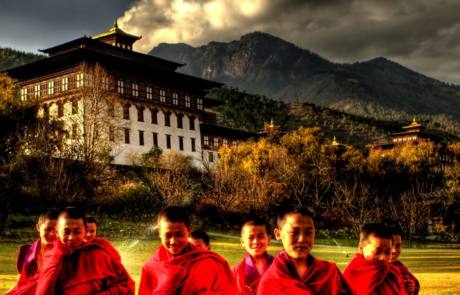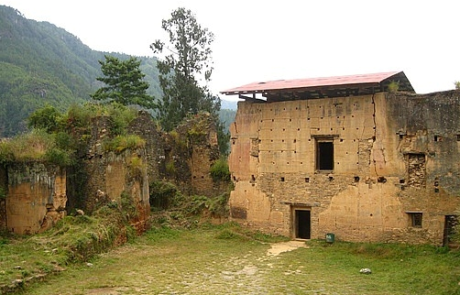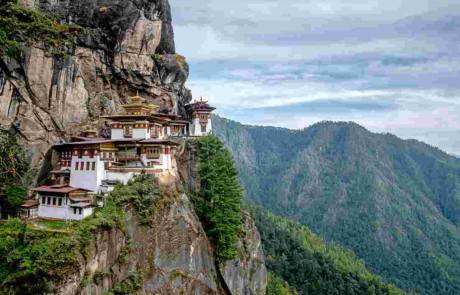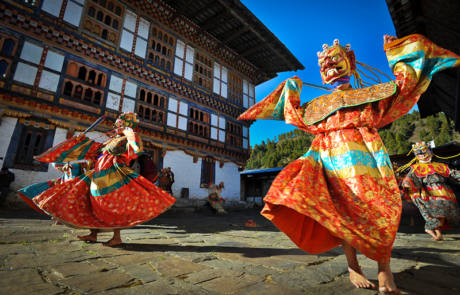5 DAYS/4 NIGHTS
BHUTAN AT A GLANCE
ABOUT
With so much to see and experience in Bhutan, how does one choose how long to stay and what to see? We have designed this trip to give you an extra-ordinary experience of life in Bhutan, from the cities and towns, to rural life, nature and the stunning landscape and, of course, the monastic life of this Buddhist Kingdom where Gross National Happiness is a higher priority than Gross National Product.
Pre-departure planning is important.
Here are certain things you should watch for and plan for.
Visas
Check with the appropriate consulate or embassy in your country to find out if you will need a visa to visit the country of your destination, especially for an extended period of time. Some countries have extremely detailed and complicated entry/departure laws, and treat visits of a week or two very differently from longer stays.
Money
If you’re traveling to one area, check the cost of living there. If it’s high you’ll probably want to budget more carefully and save some money before leaving. The lower the cost of living the less you’ll have to save, but be sure to have a back up reserve in emergency cases.
General Tips
Talk to other people who have done a similar trip.
If you don’t know anyone personally, try any of the dozens of online travel web sites full of first-person travel stories covering every possible type of trip.
Plan big and loose. Read everything you can about the area.
There may be sights and attractions you didn’t know about. A rough outline of your trip might have three or four target points and a variety of ways to get between them.
You don’t want to find out that the weather isn’t what you thought, or the guide book was incorrect, after committing to 6 weeks in a specific spot.
Some trips will allow you more leeway than others. Travel plans in Asia can often be made day-by-day while summer travel in Europe should be organized at least a few weeks ahead, unless you’re prepared to hunt around for hotel rooms and train seats.
Set up a pre-trip time-line so you don’t end up with a full todo list your last week of work or school.
Things to consider are doctor’s visits for a check up, inoculations, and prescription refills; purchasing plane tickets; renewing passports and obtaining visas and other documents.
Check your insurance coverage abroad and purchasing additional travel insurance if needed. Don’t forget visiting friends and family members!
The longer the trip, the lighter you should pack. This might seem strange, but it’s true you can afford to lug a heavy bag around for a week or two, but do you want to have anything extra for a year?
Stick to the absolute basics and know what you can and cannot buy at your destination(s). There’s no point in bringing 6 months of toothpaste to Europe or buying a sarong at home to take to the tropics. If you are visiting several climates, try to arrange it so you visit the warmer places first and coldest last. That way you can purchase sweaters and long pants and not have to carry them any more than needed. Alternately, visit cold climates first and then ship unneeded layers home — or sell them off.
A good rule of thumb is to bring one outfit for the hottest day you’re likely to encounter, one for an average day, and one for the coldest.
Make sure everything goes with everything else (if that’s important to you), and remember that layers are always best.
Be prepared for uncomfortable trips. You will often find yourself in a busy, cramped, economy class environment and it could be for many hours – especially long plane trips.
If you want to arrive at your destination refreshed and able to enjoy the sights, then try a good quality travel pillow to support your head, some ear plugs to block out the screaming babies, and an eye cover to block out the sun or cabin lights.
Just avoid those cheap U-shaped pillows from airport shops – your head drops forward and you wake up with a stiff neck.
Make contact with the locals before you go.
Maybe you have a friend-of-a-friend or a foreign exchange student from high school you remember, or just found a friend through a travel web site; almost everyone is happy to welcome a foreign visitor to their home town. This might be as elaborate as a home-stay for a few weeks, or just coffee in their home town or dinner at a locals restaurant.
Trip Attractions
Visit Punakha Dzong built in 1637
Taktsang monastery
Rimpung Dzong (Paro Dzong)
Witness archery match.
Travel Resources
Travel planning is about more than just knowing where you’re going. Prepares to navigate, take control and be ready for anything. This section helps you steer clear of disaster and stay open to enjoy the unexpected.
Quick Tips
- Banks – Open Monday to Friday 9 am to 2 pm. Some banks are closed for lunch.
- Emergencies – For police, dial a local phone number; for an ambulance call a hospital.
- Internet Access – Wifi is standard in most hotels and free in many coffee shops.
- Mail – Buy stamps at the Post Office. Convenient post offices have located in all cities. Most are open Monday to Friday 9 am to 3 pm.
- Safety – Pickpocketing can be a common problem. It is suggested for men to keep wallets in their front pockets. Purse snatching also occurs at times.
Visitor Information
This site contains information with a very personal and friendly structure. It also has great links to other related sites online.
Information, internet access, maps, and train passes are available at local Tourist Information terminals. These are located at various sites around the city. Expect a wait if you arrive late in the afternoon or during lunchtime. Local travel agencies are also helpful for quick information and finding hotels. There is no service charge for these services. Hours are Monday to Friday 9 am to 5 pm, and Saturday 10 am to 2 pm.
Transportation
Getting in from the airport and other arrival locations. Travel planning is about more than just knowing where you’re going. Prepares to navigate, take control and be ready for anything. This section helps you steer clear of disaster and stay open to enjoy the unexpected.
- Plane – Flights arrive at the main airport near the city center. If flying from European cities, you might land at a connecting airport. There is a tourist information office at the Terminal E, international arrivals, open 8 am to 6 pm.
- Train – A train station is on the lower level of the airport. To get into the city, follow the marked signs.
- Taxi – From the airport, there is a flat rate for the 1-hour trip, depending on traffic.
- Bus – Buses arrive at the city center. This is the transportation hub for the city and is surrounded by hotels.
A perfect place for exploring on foot, with local shops around every corner. You will eventually walk somewhere, it’s just going to happen. If you don’t like crowds, uneven cobblestones, heavy traffic, or narrow sidewalks, take a taxi or rent a scooter.
Itinerary Details
Day 01. Arrive at Paro ( Altitude 2280 meters)
You will be received by our representative at the airport and drive to the Hotel.
After lunch, visit the Ta Dzong, an ancient watchtower, which has been, since 1967, the National Museum of Bhutan then visit Rimpung Dzong (Paro Dzong) built-in 1646 by Shabdrung Ngawang Namgyal. The Dzong presently houses administrative offices. Dinner and overnight at the hotel in Paro.
Day 02. Paro Sightseeing – Thimphu: (Altitude 2320 m)
After breakfast, Excursion to Taktsang Monastery: A short drive takes us to Satsam Chorten, the trail climbs through beautiful pine forest, many of the trees festooned with Spanish moss, and an occasional grove of fluttering prayer flags. We stop for a rest and light refreshments at the Taktsang Jakhang (cafeteria) and then walk a short distance until we see, clearly and seemingly within reach, Taktsang monastery. The primary Lhakhang was built around Guru Rimpoche’s meditation cave in 1684 by the Penlop of Paro, Gyaltse Tenzin Rabgay; this incredible monastery clings to the edge of a sheer rock cliff that plunges 900 meters into the valley below. Legend has it that Guru Padmasambhava, the Tantric mystic who brought Buddhism to Bhutan in 747 AD, flew here on the back of a flying tiger, Dorji Drolo, said to be his favourite consort.
In the evening, visit the Drukgyel Dzong, now in ruins was built by Shabdrung Ngawang Namgyal to commemorate the victory over the Tibetan invaders in1644; the dzong name’s means indeed “ victorious Druk “. The Dzong was used as an administrative center until 1951 when a fire caused by a butter lamp destroyed it. Then visit Kyichu Lhakhang, one of Bhutan’s oldest and most sacred monasteries dating from the introduction of Buddhism in the 8th century. Then drive to Thimphu. Dinner and overnight in Hotel
Day 03. Thimphu – Punakha – Thimphu ( Altitude 1310 meters)
(83 Kms, 3 hours drive). After breakfast, drive to Punakha via Dochula pass. If the weather is clear, we stop for a while at Dochula pass to view Higher Himalayas. En route stop a while to view Chimi Lhakhang also called the “Temple of Fertility” built by Lama Drukpa Kuenley who is popularly known as “The Devine Mad Man” in the 15th century.
After lunch, visit Punakha Dzong built in 1637 by Shabdrung Ngawang Namgyal, and is situated between Pho Chu (male river) and Mo Chu (FemaleRiver). For many years until the time of the second king, it served as the seat of the Government. The construction of the Dzong was foretold by Guru Rimpoche, who predicted that “…a person named Namgyal will arrive at a hill that looks like an elephant”. There was a smaller building here called Dzong Chu (Small Dzong) that housed a statue of Buddha. It is said that Shabdrung ordered the architect, Zowe Palep, to sleep in front of the statue, while Palep was sleeping; the Shabdrung took him in his dreams to Zangtopelri (Paradise) and showed him thepalaceofGuru Rimpoche. From his vision, the architect conceived the design for the new Dzong, which in keeping with the tradition, was never committed to paper. The Dzong was named Druk Pungthang Dechen Phodrang (PalaceofGreat Happiness). The war materials captured during the battle with Tibetans are preserved here. Punakha is still the winter residence of Je-Khenpo and King Jigme Dorji Wangchuk convened the First National Assembly here in 1952. In the evening, drive to Thimphu. Dinner and overnight in Hotel.
Day 04. Thimphu sightseeing
After breakfast, visit the National Memorial Chorten, a monument dedicated to the Third King of Bhutan. His Late Majesty King, Jigme Dorji Wangchuck. The inside paintings and statues provide a very rare insight into Buddhist Philosophy. Then visit the National Library, which holds a vast collection of ancient Buddhist manuscripts followed by a visit to the painting school, famous for carving and free hand art andFolkHeritageMuseum. Then visit Sangay gang view point, Takin Preserve centre, Changangkha Monastery and Nunnery.
After lunch, visit to the tallest statue of Buddha (In the world), the weekend market, and witness an archery match. In the evening, visit Tashichho Dzong (Fortress of the Glorious Religion), built-in 1641 by Shabdrung Ngawang Namgyal and reconstructed in 1961 by the Late King, His Majesty King Jigme Dorji Wang chuck, who is regarded as the Father of Modern Bhutan. Then visit Handicrafts Emporium to see the exquisite artistry of traditional crafts and textiles. Dinner and overnight in Hotel.
Day 05. Departure:
Early morning, drive to the Airport and Farewell.




